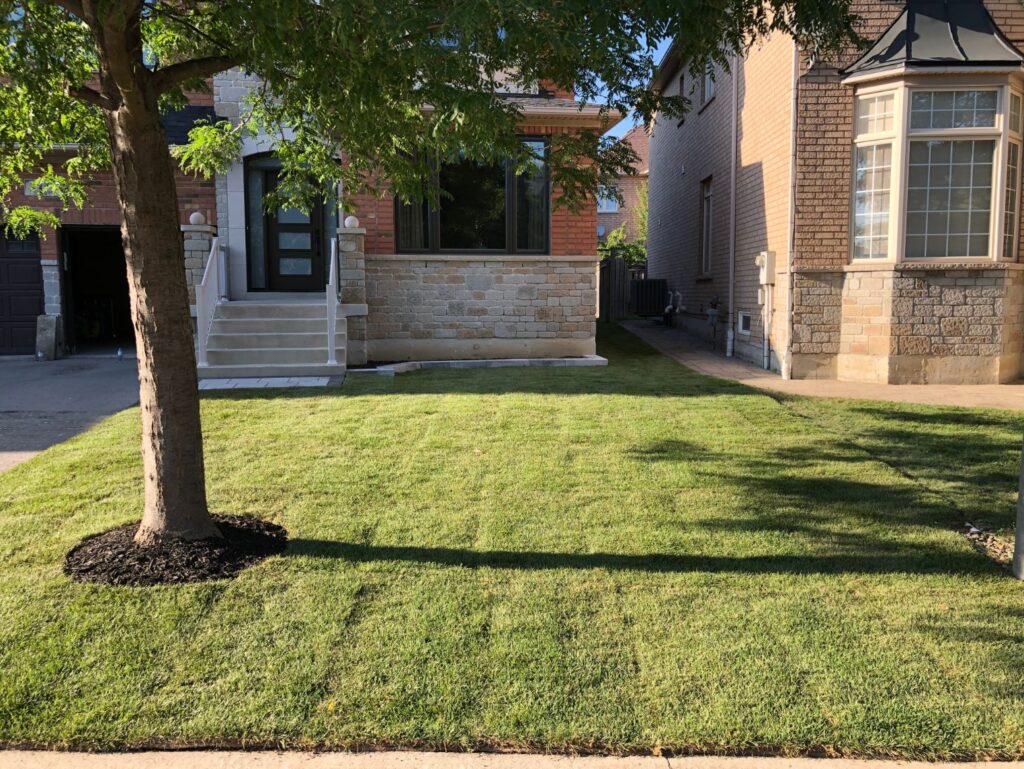Key Takeaways
- Wait at least two weeks to mow new sod
- Always perform a tug test before mowing new sod
- Never cut more than 1/3 of your sod at one time
- Mow sod either in the morning or evening
- Bag clippings for the first month following sod installation
Sod has many amazing benefits, from quickly achieving a lush lawn to reduced maintenance. However, knowing how to take care of your newly sodded lawn is key to its success and longevity. Some of the major questions people ask are when to mow new sod and how to mow new sod. Luckily, this blog has the answers to both. Read on to discover all there is know about maintaining a beautifully sodded lawn.
Why You Need to Wait to Mow New Sod?
As with any type of grass, it takes time to establish a healthy root system. Before you can mow your sod, you must wait until the roots are developed and firmly connected with the soil. Strong roots keep the sod from dislodging or becoming damaged from the lawn mower.

When Is the Right Time to Mow New Sod?
Knowing when to mow new sod is vital to the health and long-term growth of your lawn. It’s best to wait a minimum of two weeks before mowing new sod. This gives the sod sufficient time to grow and secure its roots before being put under the stress of a lawn mower. This timeframe can vary depending on the weather and soil conditions. If you’re unsure if your sod is ready for mowing, you can perform a tug test. Here’s how it works:
- Tug Test: After the two weeks have passed, gently tug at a section of your sod. If you feel resistance, it’s likely the sod has developed its roots. If the sod lifts up, that means it isn’t quite ready for mowing. Try the test again in a week to check the progress.
How to Mow New Sod
Mowing sod for the first time is slightly different from how you would mow grass seed for the time. For example, sod can be mowed within two to three weeks of laying it, whereas grass seed typically takes two to month fours months before it can be mowed. In addition to the timing, the mowing technique and height also differ. The following is a list of steps outlining how to mow new sod:


What Not to Do After Getting New Sodding
In order to promote the healthy establishment and long-term growth of your new sod, avoid the following within the first month of laying sod:
- Mowing too soon
- Walking on the sod
- Watering sod more than twice a day
- Placing heavy objects on the sod
Final Thoughts
When maintained correctly, sodded lawns can be a great addition to your front and/or back yard. Knowing when to mow new sod, what to avoid, and how to mow new sod is key to establishing a beautiful, thriving, and long-lasting lawn.
Contact Sodding GTA today for more sodding tips or professional installation!
FAQs
You should wait two to three weeks before walking on new sod to avoid unnecessary damage from foot traffic. For optimal results, keep from walking on new sod for a month when the root system is fully established.
Shallow roots are located closer to the surface of the soil, whereas deep roots are grown further into the soil. The depth of shallow roots is between 12 and 18 inches, while deep roots have a depth of 24 to 36 inches.
Sod lines typically disappear within four to six weeks. The lines are the seams of where each sod piece meets. As the root system establishes, the pieces will grow together and the lines will become less and less visible.
